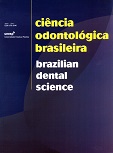Correlação entre as medidas coronárias e a espessura do esmalte proximal em primeiros pré-molares inferiores
DOI:
https://doi.org/10.14295/bds.2005.v8i3.431Abstract
Esta pesquisa teve por finalidade analisar as correlações entre as dimensões coronárias, mésio-distal, cérvico-oclusal e vestíbulo-lingual, e a espessura de esmalte proximal em pré-molares inferiores. Foram selecionados quarenta primeiros pré-molares inferiores, vinte direitos e vinte esquerdos. As medidas coronárias foram determinadas com paquímetro digital. Aferiu-se a espessura do esmalte proximal em secções dos dentes por meio de um perfilômetro. As diferenças entre as médias das dimensões coronárias e da espessura do esmalte foram avaliadas pelo teste t de student (p<0,05). A correlação entre as diversas grandezas foi analisada pelos testes de Spearman e Pearson. As dimensões mésio-distal, cérvico-oclusal e vestíbulo-lingual foram de 7,74mm e 7,57mm; 9,07mm e 8,99mm; e 7,97mm e 8,09mm, para os lados direito e esquerdo, respectivamente. A espessura do esmalte nas faces mesiais foi de 1,025mm para o lado direito e 1,063mm, para o esquerdo. Os valores correspondentes nas faces distais foram de 1,229mm e 1,293mm. Não houve diferenças significativas entre as medidas dos lados direito e esquerdo. Verificaram-se correlações entre as dimensões mésio-distal e vestíbulo-lingual, bem como entre as espessuras de esmalte mesial e distal, em ambos os lados. Desse modo, a altura cérvico-oclusal superou as medidas mésio-distal e vestíbulo-lingual, indicando que as coroas dos primeiros pré-molares inferiores apresentaram maior dimensão ocluso-apical. A espessura do esmalte foi maior nas faces distais. As dimensões mésio-distal e vestíbulo-lingual e as espessuras do esmalte proximal, dos lados direito e esquerdo, demonstraram uma relação diretamente proporcional.Downloads
Downloads
Published
How to Cite
Issue
Section
License
Brazilian Dental Science uses the Creative Commons (CC-BY 4.0) license, thus preserving the integrity of articles in an open access environment. The journal allows the author to retain publishing rights without restrictions.
=================




























